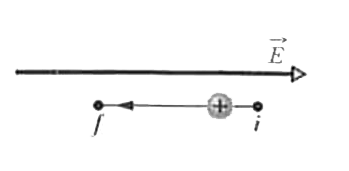Complete Solutions to CHECKPOINT of chapter ELECTRIC POTENTIAL of Class 12 book with complete answers and questions
| Class 12 | PHYSICS |
| Chapter | ELECTRIC POTENTIAL |
| RESNICK AND HALLIDAY | CHECKPOINT |
| Number Of Questions | 6 |
| Academic Year | 2023-24 |
In the figure, we move a proton from point `i` to point `f` in a uniform electric field. Is positive or negative work done by (a) the electric field and (b) our force? (c) Does the electric potential energy increase or decrease? (d) Does the proton move to a point of higher or lower electric potential?

View SolutionIn the figure of Checkpoint 1, we move the proton from point i to point fin a uniform electric field directed as shown. (a) Does our force do positive or negative work? (b) Does the proton move to a point of higher or lower potential?
View SolutionThe figure here shows a family of parallel equipotential surfaces (in cross section) and five paths along which we shall move an electron from one surface to another. (a) What is the direction of the electric field associated with the surfaces? (b) For each path, is the work we do positive, negative, or zero? ( c) Rank the paths according to the work we do, greatest first.

View SolutionThe figure shows three pairs of parallel plates with the same separation, and the electric potential of each plate. The electric field between the plates is uniform and perpendicular to the plates. (a) Rank the pairs according to the magnitude of the electric field between the plates, greatest first. (b) For which pair is the electric field pointing rightward? (c) If an electron is released midway between the third pair of plates, does it remain there, move rightward at constant speed, move leftward at constant speed, accelerate rightward, or accelerate leftward?

View SolutionIs the electrostatic field pattern shown in the figure possible? (Hint: Assume a rectangular loop in the field and find the work done by the electric field on a test charge in moving along that loop. Did you arrive at a contradiction?)
View SolutionSuppose that three points are set at equal (large) distances r from the center of the dipole in Fig. 24-33: Point a is on the dipole axis above the positive charge, point b is on the axis below the negative charge, and point c is on a perpendicular bisector through the line connecting the two charges. Rank the points according to the electric potential of the dipole there, greatest (most positive) first.
View Solution
CHECKPOINT questions and complete solutions for chapter ELECTRIC POTENTIAL of RESNICK AND HALLIDAY PHYSICS (HINGLISH) of Class 12
All Exercises from RESNICK AND HALLIDAY Class 12 PHYSICS ELECTRIC POTENTIAL
- (PRACTICE QUESTIONS) Integer Type
- (PRACTICE QUESTIONS) Linked Comprehension
- (PRACTICE QUESTIONS) Matrix-Match
- (PRACTICE QUESTIONS) More than One Correct Choice Type
- (PRACTICE QUESTIONS) Single Correct Choice Type
- (PROBLEMS)
- CHECKPOINT
- SAMPLE PROBLEM 24.01 Work and potential energy in an electric field
- SAMPLE PROBLEM 24.02 Distance, velocity, closest separation for charged particle projected from ∞ towards fixed particle
- SAMPLE PROBLEM 24.03 Locating equipotential surfaces
- SAMPLE PROBLEM 24.04 Finding the potential change from the electric field
- SAMPLE PROBLEM 24.05 Finding electric potential
- SAMPLE PROBLEM 24.06 Finding the potential
- SAMPLE PROBLEM 24.07 Net potential of several charged particles
- SAMPLE PROBLEM 24.08 Potential is not a vector, orientation is irrelevant
- SAMPLE PROBLEM 24.09 Net potential due to two charged particles
- SAMPLE PROBLEM 24.10 Potential due to line of charge
- SAMPLE PROBLEM 24.11 Finding potential of charged disk
- SAMPLE PROBLEM 24.12 Potential due to infinite sheet of charge
- SAMPLE PROBLEM 24.13 Potential at the surface of the outer shell
- SAMPLE PROBLEM 24.14 Field and potential inside a charged spherical shell
- SAMPLE PROBLEM 24.15 Point charge projected from a large distance towards center of fixed charged ring
- SAMPLE PROBLEM 24.16 Finding the field from the potential
- SAMPLE PROBLEM 24.17 Acceleration of charge of given potential
- SAMPLE PROBLEM 24.18 Electric field due to a dipole at a point on dipole axis
- SAMPLE PROBLEM 24.19 Resultant potential and electric field of dipoles
- SAMPLE PROBLEM 24.20 Dipole moment of combination of three charges
- SAMPLE PROBLEM 24.21 Potential energy of a system of three charged particles
- SAMPLE PROBLEM 24.22 Conservation of mechanical energy with electric potential energy
- SAMPLE PROBLEM 24.23 Finding potential on spherical conducting shell due to point charge kept outside the shell
- SAMPLE PROBLEM 24.24 Potential due to charges on three concentric shells
- SAMPLE PROBLEM 24.25 Charge and potential on a conductor that is earthed
- SAMPLE PROBLEM 24.26 Self-energy of a uniformly charged sphere
- SAMPLE PROBLEM 24.27 Electrostatic energy of two charged conducting shells, with and without earthing